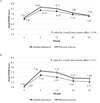Effect of Physical Activity versus Health Education on Physical Function, Grip Strength and Mobility
- PMID: 28221668
- PMCID: PMC5507738
- DOI: 10.1111/jgs.14804
Effect of Physical Activity versus Health Education on Physical Function, Grip Strength and Mobility
Abstract
Background: Physical activity (PA) reduces the rate of mobility disability, compared with health education (HE), in at risk older adults. It is important to understand aspects of performance contributing to this benefit.
Objective: To evaluate intervention effects on tertiary physical performance outcomes.
Design: The Lifestyle Interventions and Independence for Elders (LIFE) was a multi-centered, single-blind randomized trial of older adults.
Setting: Eight field centers throughout the United States.
Participants: 1635 adults aged 78.9 ± 5.2 years, 67.2% women at risk for mobility disability (Short Physical Performance Battery [SPPB] <10).
Interventions: Moderate PA including walking, resistance and balance training compared with HE consisting of topics relevant to older adults.
Outcomes: Grip strength, SPPB score and its components (balance, 4 m gait speed, and chair-stands), as well as 400 m walking speed.
Results: Total SPPB score was higher in PA versus HE across all follow-up times (overall P = .04) as was the chair-stand component (overall P < .001). No intervention effects were observed for balance (overall P = .12), 4 m gait speed (overall P = .78), or grip strength (overall P = .62). However, 400 m walking speed was faster in PA versus HE group (overall P =<.001). In separate models, 29% of the rate reduction of major mobility disability in the PA versus HE group was explained by change in SPPB score, while 39% was explained by change in the chair stand component.
Conclusion: Lower extremity performance (SPPB) was significantly higher in the PA compared with HE group. Changes in chair-stand score explained a considerable portion of the effect of PA on the reduction of major mobility disability-consistent with the idea that preserving muscle strength/power may be important for the prevention of major mobility disability.
Keywords: gait speed; physical activity; physical function; randomized clinical trial.
© 2017, Copyright the Authors Journal compilation © 2017, The American Geriatrics Society.
Conflict of interest statement
Figures


References
-
- Cesari M, Kritchevsky SB, Penninx BWHJ, et al. Prognostic Value of Usual Gait Speed in Well-Functioning Older People—Results from the Health, Aging and Body Composition Study. Journal of the American Geriatrics Society. 2005;53:1675–1680. - PubMed
-
- Guralnik JM, Ferrucci L, Pieper CF, et al. Lower Extremity Function and Subsequent Disability. The Journals of Gerontology Series A: Biological Sciences and Medical Sciences. 2000;55:M221–M231. - PubMed
-
- Rantanen T, Guralnik JM, Foley D, et al. Midlife hand grip strength as a predictor of old age disability. JAMA. 1999;281:558–560. - PubMed
Publication types
MeSH terms
Grants and funding
LinkOut - more resources
Full Text Sources
Other Literature Sources
Medical

